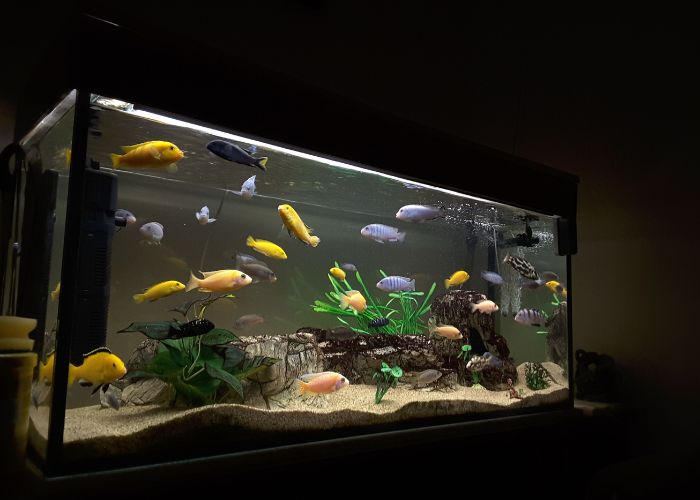Not only does an aquarium with bright lighting look great, but it also helps the fish and other aquatic creatures in it stay healthy. This exposition will dig into the complexities of picking the best lighting arrangement for a home aquarium, taking into account the different necessities of oceanic conditions. Let’s read below,”What is the best lighting setup for a home aquarium?”.
Table of Contents
Understanding the Importance of Aquarium Lighting:
Understanding the need of legitimate lighting for a home aquarium is vital prior to digging into explicit lighting plans. Light is essential to the existence, growth, and behavior of all aquarium organisms.
The photosynthetic cycle is crucial to the advancement of the amphibian food web’s fundamental living beings, the green growth and plants. Daylight, when present in nature, gives the phantom light fundamental for this undertaking.
Artificial lighting that replicates the sun’s spectrum is necessary for the maintenance of aquatic life in a home aquarium, including fish, plants, and invertebrates. A precise combination of light intensity and duration is required for photosynthesis to occur, a process vital to plant life that generates oxygen and removes carbon dioxide from the air.
Factors Influencing the Choice of Lighting Setup:
Type of Aquarium:
Freshwater Aquariums: plants, and even invertebrates. Lighting in freshwater ecosystems should mimic the light spectrum for best photosynthesis and plant growth.
Saltwater Aquariums: which are saltwater aquariums, and other marine habitats require specialised lighting. Corals, which are photosensitive, require a brightly illuminated saltwater tank to thrive and display their vibrant colours.
Aquarium Size and Depth:
The depth and size of an aquarium determine the quantity of light that can enter. More powerful lighting systems may be required to reach the base of tanks with a deeper depth of water.
Type of Inhabitants:
Different species have vastly different light requirements. For example, in freshwater aquariums, plants that do well in bright light necessitate high illumination, yet other fish prefer lower lighting levels at night.
Duration of Light Exposure:
By manipulating the duration of light exposure, the day and night cycles can be reproduced. Disrupting the delicate biological balance, an overabundance of light can cause algae to overgrow, while a shortage of light can inhibit plant growth.
Budget and Energy Efficiency:
There is a wide range in lighting setup prices. You must consider the initial investment in light of the long-term savings in energy and maintenance costs.
Common Types of Aquarium Lighting:
Fluorescent Lighting
Conventional incandescent light bulbs were the norm for aquarium illumination for quite some time. Inexpensive and effective with low-light, straightforward setups, they are a great value. However, they may not be able to handle complex environments, such as reef aquariums.
LED Lighting:
Lighting up aquariums with Light Emitting Diode (LED) lights has changed the game. Energy-efficient, customisable, and available in a rainbow of hues, LED lights are fantastic. This is why they work wonderfully in both saltwater and freshwater aquariums. It is common for the extra initial expense to be justified by the long-term benefits.
Metal Halide Lighting:
Metal halide lamps produce intense, deep illumination, making them ideal for aquariums with deep water or complex layouts, such as reef tanks. On the other hand, they’re hotter and use more energy than LED lights.
Choosing the best lighting setup for a home aquarium
Full Spectrum:
Natural sunshine is a good analogy for the balanced colour range that a full spectrum light source produces. Because it promotes the growth of plants and corals, this is ideal for planted freshwater aquariums and reef tanks.
Blue Spectrum:
Corals in reef aquariums can’t survive without blue light. Within coral cells live symbiotic zooxanthellae, which enhance coral fluorescence and boost photosynthesis.
RGB (Red, Green, Blue) Lighting:
Using RGB LED fixtures, even a novice may create unique lighting effects by adjusting the colour spectrum. Make sure the spectrum is appropriate for the fish and other aquatic life, even though this could enhance the aquarium’s aesthetic appeal.
Tips for Implementing an Effective Lighting Setup:
Gradual Acclimatization:
It is crucial to ease the aquarium inhabitants into new illumination or increase the intensity slowly. Abrupt alterations can cause creatures to acquire stress and health concerns.
Lighting Control Timers:
If you want to keep a consistent day-to-night cycle, use timers to control how long the lights stay on. Furthermore, it forestalls overexposure, which lessens the possibilities of algal sprouts.
Regular Maintenance:
Keep the light installations clean for ideal execution. Trash and green growth can decrease light’s adequacy by impeding its infiltration.
Monitor and Adjust:
Never let your watchman down with regards to keeping an eye on the aquarium’s coral and plants. While changing the splendor and term of the lighting, remember the particular requirements of the occupants.
Conclusion:
The lighting arrangement of a home aquarium has a direct impact on the vitality and health of the ecosystem. Make sure you know how much light each species needs before setting up a reef tank or freshwater aquarium with plants.
Light-emitting diode (LED) technologies that are now more effective have given aquarium enthusiasts more adaptable and user-friendly lighting options. Cautious thought of elements like aquarium size, light range, and kind permits home aquarium devotees to develop outwardly gorgeous and harmless to the ecosystem environments. I hope you like rading,”What is the best lighting setup for a home aquarium?”.

Lena Whitmore is the lead writer at FishClans.com, bringing over 10 years of fishkeeping expertise and a master’s degree in Marine Biology to the site. Her extensive knowledge and practical tips have established her as a respected authority in the aquarist community. Lena’s work has appeared in leading publications and she frequently speaks at industry events.
Connect with Lena and FishClans on Facebook, Pinterest, and Instagram.

